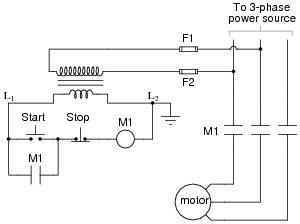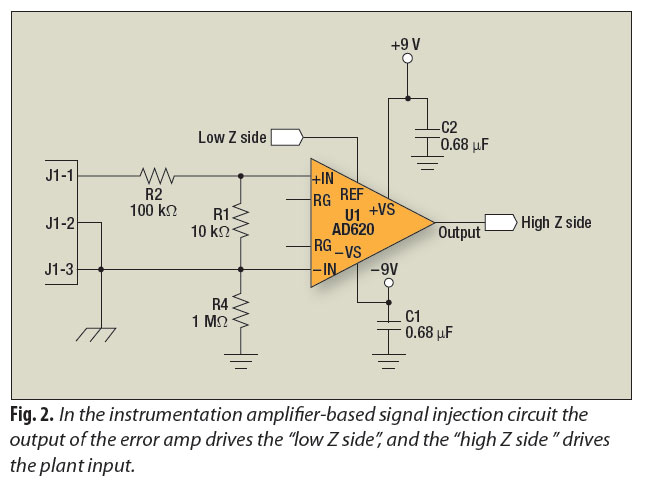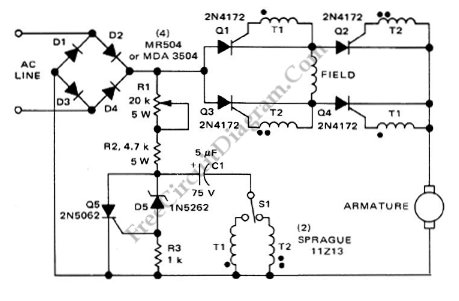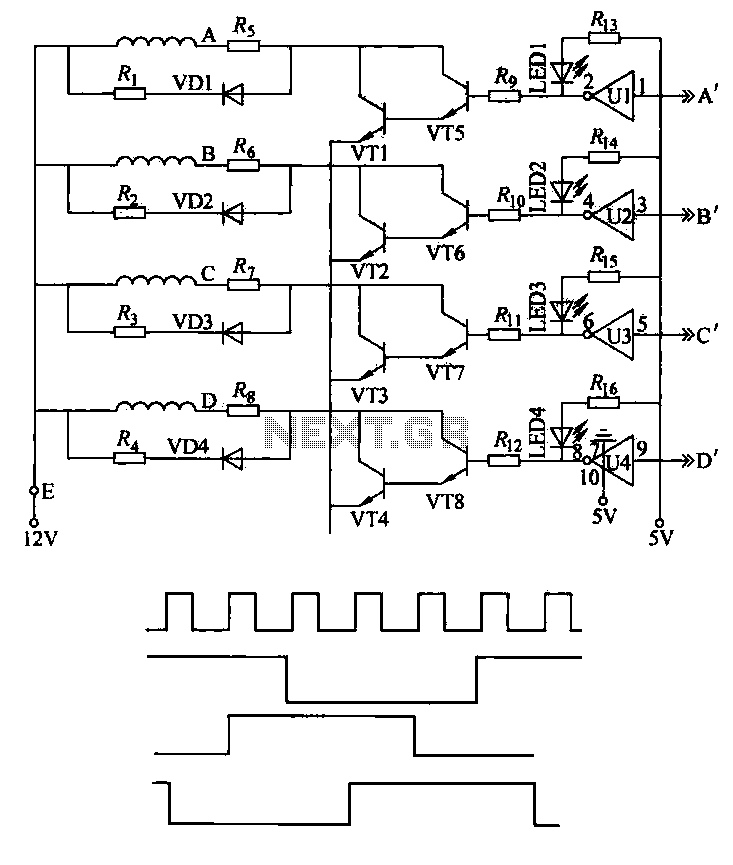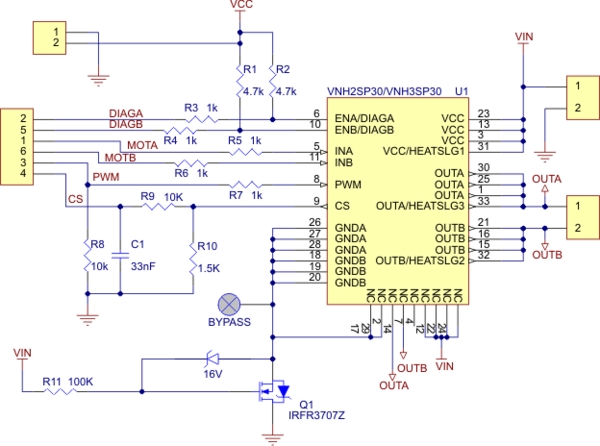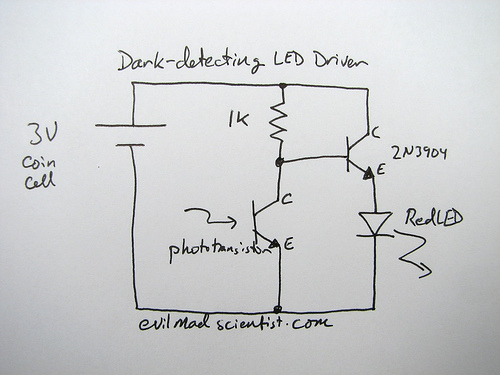
Simple DC motor PWN speed controls

The 555 IC is configured in an astable mode, producing a frequency that remains constant and is independent of the duty cycle. The total resistance (Rcharge + Rdischarge, considering the diode) is fixed at 22 kΩ, yielding a frequency of approximately 1 kHz, which may produce an audible hum. When the potentiometer is fully turned up, Rcharge is 1 kΩ (the diode prevents the capacitor from charging through the second potentiometer section and the additional 1 kΩ resistor), while Rdischarge is 21 kΩ, resulting in a duty cycle of 5% at a frequency of 1 kHz. Conversely, when the potentiometer is fully turned down, Rcharge is 21 kΩ, and Rdischarge is 1 kΩ, leading to a duty cycle of 95% at the same frequency. At the midpoint setting of the potentiometer, Rcharge becomes 11 kΩ and Rdischarge is also 11 kΩ, producing a 50% duty cycle at 1 kHz. To mitigate the audible hum from the motor, one may consider increasing the frequency beyond the audible range by replacing the potentiometer. However, it is important to note that at higher frequencies, the inductive reactance of the motor increases, which may reduce efficiency. It is crucial that the MOSFET (or bipolar transistor) has sufficient current capacity to drive the motor, with the drain (or collector) current needing to match the maximum motor current at the power supply voltage when turned off. A snubber diode is also necessary, as it shorts the motor during the off cycle. Both the MOSFET (or bipolar transistor) and diode must be connected to a heatsink if the maximum motor current exceeds 100 or 200 mA to prevent overheating. It is advisable to avoid overloading the motor, as excessive work can lead to overheating of the motor, transistor, and diode. To eliminate braking during the off cycle, a resistor can be placed in series with the snubber diode, which may slightly improve efficiency but will increase inertia when slowing the motor. The resistor value should be calculated as R = V(breakdown transistor) / Imax, with a power rating of 5W. Although MOSFETs have an internal Zener diode, reliance on it for protection is not recommended.
The circuit utilizes a 555 timer IC configured in an astable mode to generate a square wave output. This configuration allows for continuous oscillation, producing a repetitive signal ideal for driving motors or other inductive loads. The frequency of the output signal is determined by the resistances and capacitance in the circuit. The resistors Rcharge and Rdischarge set the charge and discharge times of the timing capacitor, respectively, while the diode ensures that the capacitor charges through the intended path, preventing interference from other components.
The choice of components, particularly the MOSFET or bipolar transistor, is critical as it must handle the maximum current required by the motor. The snubber diode serves to protect the switching device from voltage spikes generated when the motor is turned off, which can otherwise damage sensitive components. Additionally, the use of a heatsink is essential for thermal management, especially when operating under high load conditions.
The inclusion of a series resistor with the snubber diode can be a strategic decision to enhance efficiency by reducing the current flowing through the diode during the off cycle, thus minimizing energy loss. However, it is crucial to balance this with the need for adequate deceleration of the motor, as a higher resistance may lead to increased inertia.
Overall, careful consideration of component ratings, configurations, and thermal management strategies is essential for the successful implementation of this circuit, ensuring reliable operation while maximizing performance and efficiency.The 555 Ic is wired as an astable and the frequency is constant and independent of the duty cycle, as the total resistance (R charge + R discharge, notice the diode) is constant and equal to 22Kohm (givin a frequency of about 1Khz, notice the hum). When the potentiomenter is all up, the Rcharge resistance is 1, 0 Kohm (the diode prevents the capaci
tor to charge through the second potentiometer section and the other 1, 0 Kohm resistor), and Rdischarge is 21 Kohm, giving a 5% on duty cycle and a 1Khz frequency. When the potentiomenter is all down, the Rcharge resistance is 21, 0 Kohm (the diode prevents the capacitor to charge through the second potentiometer section and the other 1, 0 Kohm resistor), and Rdischarge is 1 Kohm, giving a 95% on duty cycle and a 1Khz frequency.
When the potentiomenter is at 50%, the Rcharge resistance is 11, 0 Kohm (the diode prevents the capacitor to charge through the second potentiometer section and the other 1, 0 Kohm resistor), and Rdischarge is 11 Kohm, giving a 50% on duty cycle and a 1Khz frequency. If you are disgusted by the 1Khz hum of the motor try to rise the frequency out of the audible range (replacing the potenziometer), but rembember that at higher frequency inductive reactance of motor rises so the the efficiency would drop.
Obviously the mosfet (or bipolar) must have enough current capability to drive the motor, so the drain (or collector) current must be equal to maximum motor current (at power supply voltage, when it is blocked). The snubber diode too, because it shorts the motor on the off cycle. Both mosfet (or bipolar) and diode have to be hooked (if you don`t want them cooked ;-) ) to a heatsink if the max motor current is more than 100 or 200mA.
I suggest to not stress to much the motor with too much work because it overheats both motor, transistor and diode. If you don`t want braking in the off cycle just place a resistor in series with the snubber diode, it should rise a bit efficiency but have more inertia when slowing the motor down.
The value of the resistor must be R=V(breakdown transistor) / Imax, and the power should be 5W. Mosfets have internal zener diode, but don`t count on it ;-) 🔗 External reference
The circuit utilizes a 555 timer IC configured in an astable mode to generate a square wave output. This configuration allows for continuous oscillation, producing a repetitive signal ideal for driving motors or other inductive loads. The frequency of the output signal is determined by the resistances and capacitance in the circuit. The resistors Rcharge and Rdischarge set the charge and discharge times of the timing capacitor, respectively, while the diode ensures that the capacitor charges through the intended path, preventing interference from other components.
The choice of components, particularly the MOSFET or bipolar transistor, is critical as it must handle the maximum current required by the motor. The snubber diode serves to protect the switching device from voltage spikes generated when the motor is turned off, which can otherwise damage sensitive components. Additionally, the use of a heatsink is essential for thermal management, especially when operating under high load conditions.
The inclusion of a series resistor with the snubber diode can be a strategic decision to enhance efficiency by reducing the current flowing through the diode during the off cycle, thus minimizing energy loss. However, it is crucial to balance this with the need for adequate deceleration of the motor, as a higher resistance may lead to increased inertia.
Overall, careful consideration of component ratings, configurations, and thermal management strategies is essential for the successful implementation of this circuit, ensuring reliable operation while maximizing performance and efficiency.The 555 Ic is wired as an astable and the frequency is constant and independent of the duty cycle, as the total resistance (R charge + R discharge, notice the diode) is constant and equal to 22Kohm (givin a frequency of about 1Khz, notice the hum). When the potentiomenter is all up, the Rcharge resistance is 1, 0 Kohm (the diode prevents the capaci
tor to charge through the second potentiometer section and the other 1, 0 Kohm resistor), and Rdischarge is 21 Kohm, giving a 5% on duty cycle and a 1Khz frequency. When the potentiomenter is all down, the Rcharge resistance is 21, 0 Kohm (the diode prevents the capacitor to charge through the second potentiometer section and the other 1, 0 Kohm resistor), and Rdischarge is 1 Kohm, giving a 95% on duty cycle and a 1Khz frequency.
When the potentiomenter is at 50%, the Rcharge resistance is 11, 0 Kohm (the diode prevents the capacitor to charge through the second potentiometer section and the other 1, 0 Kohm resistor), and Rdischarge is 11 Kohm, giving a 50% on duty cycle and a 1Khz frequency. If you are disgusted by the 1Khz hum of the motor try to rise the frequency out of the audible range (replacing the potenziometer), but rembember that at higher frequency inductive reactance of motor rises so the the efficiency would drop.
Obviously the mosfet (or bipolar) must have enough current capability to drive the motor, so the drain (or collector) current must be equal to maximum motor current (at power supply voltage, when it is blocked). The snubber diode too, because it shorts the motor on the off cycle. Both mosfet (or bipolar) and diode have to be hooked (if you don`t want them cooked ;-) ) to a heatsink if the max motor current is more than 100 or 200mA.
I suggest to not stress to much the motor with too much work because it overheats both motor, transistor and diode. If you don`t want braking in the off cycle just place a resistor in series with the snubber diode, it should rise a bit efficiency but have more inertia when slowing the motor down.
The value of the resistor must be R=V(breakdown transistor) / Imax, and the power should be 5W. Mosfets have internal zener diode, but don`t count on it ;-) 🔗 External reference
